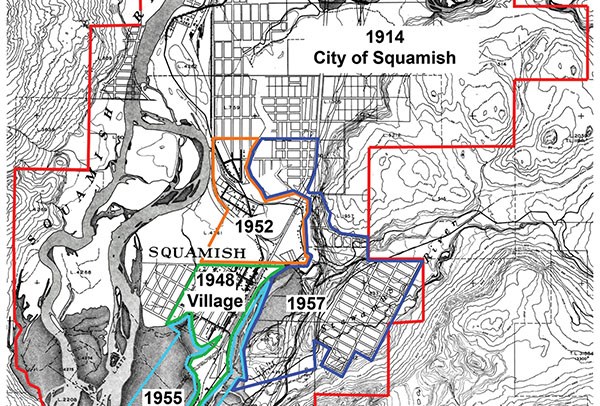Squamish has been incorporated or reincorporated several times during the past 100 years.
In fact, the first attempt to incorporate a “Municipal Township of Squamish,” extending from Brackendale to the harbour, was in 1892. This was during the period when the hops-raising industry was getting started, and it was an initiative supported by hops industry investors alongside the local settlers.
Better roads and flood protection, improving community infrastructure — these were the primary impetus for incorporating and then expanding an organized municipality in the Squamish Valley.
The next incorporation initiative — this time followed through upon — was in 1914. The Pacific Great Eastern Railway joined with the local businessmen of the Newport and District Board of Trade in the initiative.
Incorporation as the “City of Squamish” was in part a means to have everyone working together in developing Squamish as a real estate venture. Although the PGE was a dominant landowner, having acquired the delta Indian Reserve lands, there were other real estate interests in the townsite and surrounding district.
Rival townsite projects — say, one in the area later to be known as Dentville and another focused on the PGE’s local properties — were to be avoided.
The last transaction records we have of the “City of Squamish” are 1915 applications with the federal government for water lots in the harbour. At some point, due to economic and wartime circumstances, its Letters Patent were surrendered.
The boundaries of the City of Squamish extended from the harbour to as far north as Diamond Road in today’s Garibaldi Estates. It was to be another half century before an organized municipality would again encompass that much of the lower valley.
From the end of WWI to the post-WWII years, the district’s economy and population did not really grow very much. The valley was still isolated, and the Squamish townsite of 1914 remained essentially unchanged for a long time.
The townsite was managed by the Squamish Board of Trade, the railway company, and the Provincial Public Works Department. The Squamish Valley Farmers’ Institute came to play an important role elsewhere in the valley, organizing and advocating for various services and improvements.
Village incorporation in 1948 was a project of the Board of Trade. Finally, the town had a local taxing authority and better ability to lobby for flood control.
As new residential areas grew during the following period, they came to be organized under utility boards.
The first expansion project of the tiny Village of Squamish was to amalgamate in 1952 with the “North Squamish Light District” — Dentville.
Later expansions and re-incorporations took in the waterfront and the heights surrounding the townsite. Originally envisioned and surveyed back in 1913 as residential areas looking out over the industrial-commercial hub below, today’s Smoke Bluffs and Southridge were absorbed in a 1957 expansion.
As a Village Corporation could only be 2,000 acres or less, the next expansion drawing in Mamquam and Brackendale in 1964 brought a new name — the “District Municipality of Squamish.”




